Science Hack Day 2013 in San Francisco took place in California Academy of Sciences this weekend.
This is the group photo inside the planetarium- yay!

Photo CC-BY-SA Matt Biddulph
Summary Video:
Datasets available: http://sciencehackday.pbworks.com/w/page/24500475/Datasets
List of projects: http://sciencehackday.pbworks.com/w/page/69019453/sfhacks2013
Opening
Saturday morning, the event started! Registration, breakfast, and intro talk.
Even the name tags were science and cute, with stickers of your selection from robots and stars etc.

My name tag:

Breakfast


Lightning Talks
There were 4 rounds of Lightning Talks in 3 rooms during day1 morning.
First round of Lightning Talks:
-Intro to Viz (Ryan Wyatt, California Academy of Sciences)
-DIY Life Detection in Extreme Environments, and Mars (Chris McKay, NASA)
-Anyone Can Be a Neuroscientist (Zarinah Agnew, Institute for Cognitive Neuroscience)
I joined "DIY brain mapping / Anyone can be a Neuroscientist!" talk.

Second round of Lightning Talks:
-Hacking Particle Physics (Matt Bellis, Siena College)
-Digital Mapmaking + DataViz 101 (Beth Schechter, Stamen)
-Do-It-Yourself Biology (Patrik D’haeseleer, BioCurious)
I joined "DIY bio" talk. We can do lots of experiments that were only available in expensive labs in the past- revolutionizing bio researches!
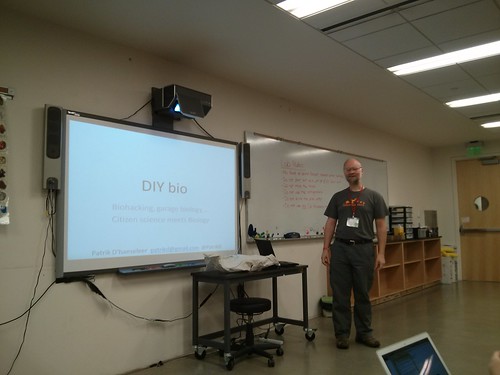


Webcam microscopes, OpenPCR (open hardware DNA copier)... we can do many things!




Biocurious projects

In the previous years they did DNAquiri and Jello Shot Electrophoresis. This year they had 3 project ideas:
Idea1: Heart in a jar
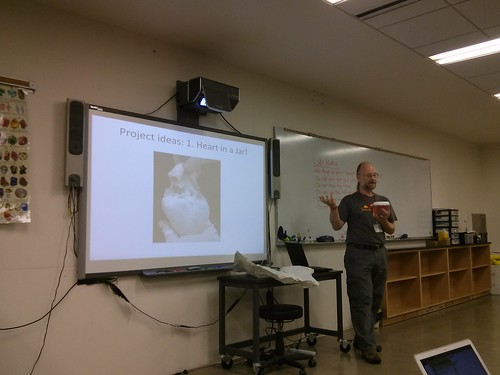
Idea2: distillation of essential oils

Idea3: microbial colors

Audience watching the speaker in the Academy lab.

Third round of Lightning Talks:
-Exploring the Data of Space (Sean Herron, FDA, formerly NASA)
-Biodiversity Datasets (Heather Yager & Kelly Jensen, California Academy of Sciences)
-Data Visualization in Higher Dimensions (Isaac Cohen, Leap Motion)
I joined "Exploring the Data of Space" talk.



NASA collects 27 tera bytes of data per day. Those data should be analyzed and used.
However, there are so many rocket scientists, but so few devs. People like those in the room are essential!

There are lots of data that can be used, there are also lots of examples we can look at.
{MAAS} API http://marsweather.ingenology.com/
"Sol" is the world's first interplanetary weather app.

"Open Notify" is open APIs from space.

Museum of inner solar system
Aurora Localization via Starfields
Planet hunters
NASA provides data, developers provide contents :D
Data.nasa is like Yellowpage of Nasa's data.
Society of Amateur Radio Astronomers
Open source planetarium "Stellarium"
"Those data belong to the public, if we don't utilize it, it's a waste so let's use it!"
Space projects are great for education too!

Fourth round of Lightning Talks:
-Turning the World into Data using Sensors and Arduinos (Peter Sand, ManyLabs)
-AntWeb: Building the Online Global Ant Museum (Brian Fisher, California Academy of Sciences)
-Citizen Science Data Central (Nina DiPrimio, citizen scientist)
I joined "Citizen Science Data Central" session.

This session was discussion not a talk. Ideas that came out from the session:
-Let's build a data repository to help citizen scientists submit and comment on open data.
-Create Github for research/science
-Make things open by default .. some of the data is private without a reason not to be public
-Catalogue data and make it usable
-Place to post their research and make journals in the future (currently people are just blogging, no place to post and share)
-Use existing things, rather than making one
-Disconnect between academia and citizen science community
-Build a new community (Website, forum, place to post data)
-What do people use now? - Twitter, Facebook, Wordpress, YouTube etc
-DNA barcoding
Lunch
Lunch time, and many people were discussing what project they will be working on.




Hacking time!
The Lab and classroom in the 3rd floor were mainly used for hardware hacking and physical projects. (And yes, I was in 3rd floor most of the time!)







Hacking the Brain





Hacking the sound



Hacking fishes and ants







Hacking house, furniture and health



Hacking bio






Great to see lots of "father and child" projects. The next generation hackers!


Lots of 3D printers.

3D printer made with 3D printer, created by Matthew Bennett.




Scull found in the Academy, 3D scanned on the spot and printed (with a 3D printed 3D printer).




Using Primesense Carmine (technology used in Kinect), and by just getting a Kinect-like camera surrounding you, you can get yourself 3D scanned, and export it in various file formats including stl file.





So, of course I got myself 3D scanned too!



Folks from Leap Motion were there handing out Leap Motion devices and giving advice. Taking this opportunity, I started playing with leapjs- JavaScript client for the Leap Motion Controller. I was amazed how super easy it is to use, and they have lots of samples here that you can play with. Thank you Leap Motion team!!

2F was used mainly for software hacking. Big window, lots of sunlight!


Collaboration
People offering help

People seeking help

Atmosphere
It was a great privilege to be able to hack surrounded by such awesome environment!!






























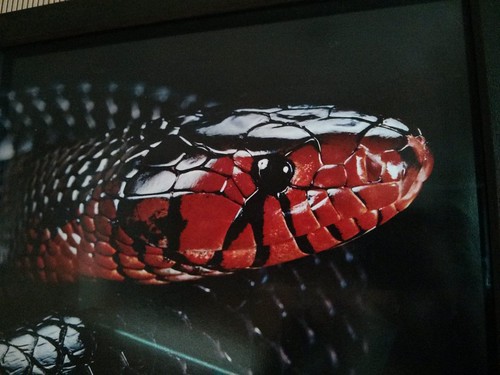



Tour of the Academy of Sciences Archives
Thanks to Kelly and Heather who works in the Academy, we were able to learn about the history of the Academy, see various precious books and photos and archives from the Academy.
Former Academy was located on Market street, and most of the archive was burned because of the big San Francisco earth quake in 1906. Earth quake and preservation means a lot to them, and they run the 'earthquake" exhibition at the Academy.
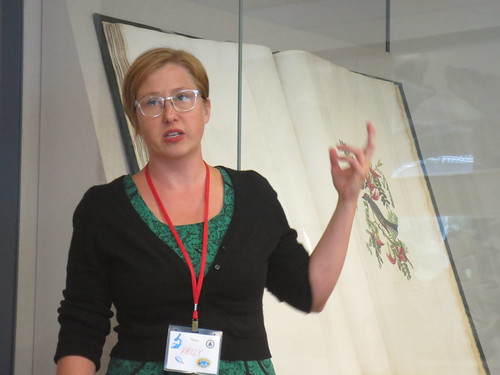


We got inside the Academy archive area. They have movable shelves.





Many boxes...

Some boxes have archives from trips to Galapagos!

And they had this beautiful pictures painted by a Japanese artist. They couldn't shoot photos, so they brought artist to record what they saw back then.


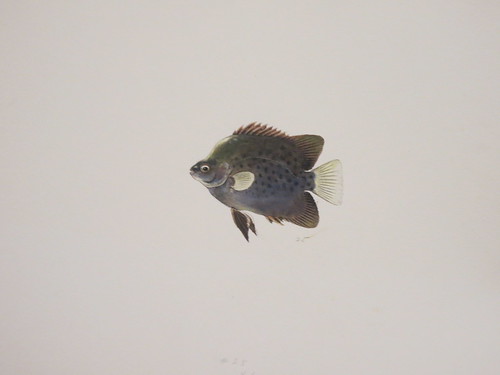
This is a cane of the first president of the Academy. The carvings are amazing. Most of all, I was fascinated by Kelly and Heather who took us to the tour- they are absolutely in love of what they have in the archives, and shared their findings with love. They were really happy to share what they found with us, and see the smiles!!


More picture books, photos.



"The cutest pictures of rhinoceros ever."


It's a trap!!

Planetarium
Academy close at 17:00, but we got to stay- and had a special private tour of the universe in the Planetarium! Unfortunately we can't turn on our smartphones so no photos ;)

Dinner


Stargazing
At 10PM, we went out to do stargazing on the roof of the Academy- the "Living Roof". We had an astronomer explain to us and answer all the questions we had about the stars! Oh, and those lasers that you can point to stars are tempting... I want one ;)
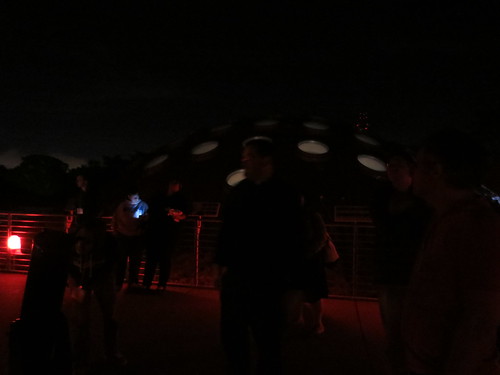


Night view of De Young Museum from Academy.

Some people went out to play "Cards Against Science".
Sleepover!
Initially I was planning to sleep with the penguins in the African Hall.



It is hard to see in the photo above, but this is how this place looks during the day. Geez, it looks soooo different!

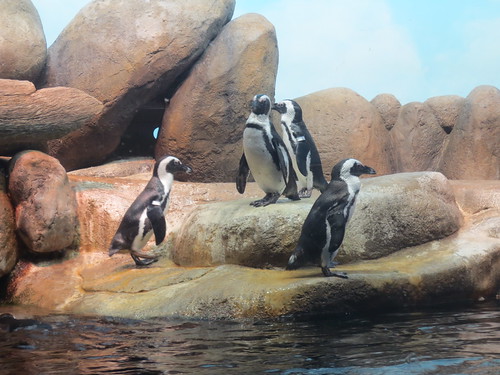


I found another nice place to sleep, under the fish tube tank in the Aquarium.



This is how my "bed for the night" looks during the day ;)


Science hackers sleeping with Jelly fish, sea dragons, fishes and turtles...




Academy at night.




Day 2 starts, breakfast, Yoga and WALL-E, Space X rocket launch!
Since the animals needs to wake up, we woke up at 6:15AM. The first thing to see when I woke up and looked up is this. Happy morning!

Since we were sleeping on the floor, my back was stiff, but morning yoga soothed it all, and I almost forgot that I was sleeping on the floor for the rest of the day. Thank you Ariel's mom!!
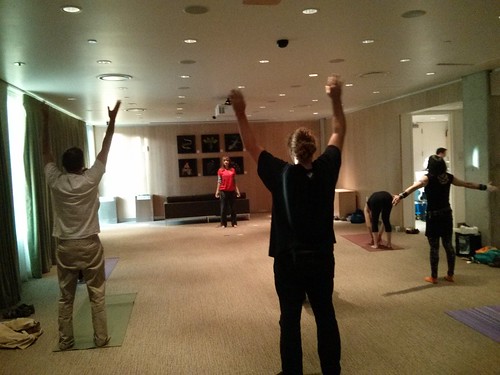
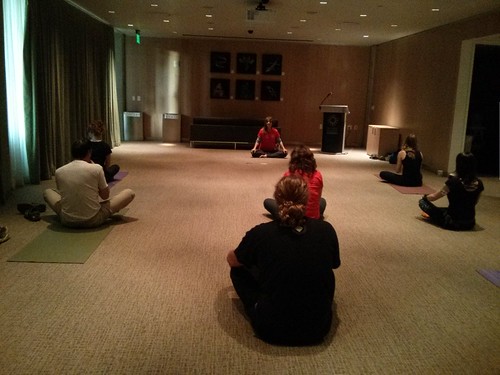
Breakfast


Pajama and bag just fit for this event. Star Wars!

WALL-E viewing

Watched Space X launch livestream!


In case you missed it, this is the archive.
Swags!






360 degree panorama of the lab :)
It's already too long, so I will make another blog post about the projects and presentations separately.
http://fumiopen.blogspot.com/2013/10/science-hack-day-presentations.html
Thanks to +Ariel Waldman and the staffs, volunteers and everyone who made this awesome event to happen, and letting me join. It was an amazing and awesome event!

Disclaimer: The opinions expressed here are my own, and do not reflect those of my employer. -Fumi Yamazaki
This is the group photo inside the planetarium- yay!

Photo CC-BY-SA Matt Biddulph
Summary Video:
Datasets available: http://sciencehackday.pbworks.com/w/page/24500475/Datasets
List of projects: http://sciencehackday.pbworks.com/w/page/69019453/sfhacks2013
Saturday morning, the event started! Registration, breakfast, and intro talk.
Even the name tags were science and cute, with stickers of your selection from robots and stars etc.

My name tag:

Breakfast


Lightning Talks
There were 4 rounds of Lightning Talks in 3 rooms during day1 morning.
First round of Lightning Talks:
-Intro to Viz (Ryan Wyatt, California Academy of Sciences)
-DIY Life Detection in Extreme Environments, and Mars (Chris McKay, NASA)
-Anyone Can Be a Neuroscientist (Zarinah Agnew, Institute for Cognitive Neuroscience)
I joined "DIY brain mapping / Anyone can be a Neuroscientist!" talk.
BrainMap is a database of published functional and structural neuroimaging experiments with coordinate-based results (x,y,z) in Talairach or MNI space. The goal of BrainMap is to develop software and tools to share neuroimaging results and enable meta-analysis of studies of human brain function and structure in healthy and diseased subjects.Project idea: putting sensor in your mouth, getting sound from mouth and see how it affects the brain.

Second round of Lightning Talks:
-Hacking Particle Physics (Matt Bellis, Siena College)
-Digital Mapmaking + DataViz 101 (Beth Schechter, Stamen)
-Do-It-Yourself Biology (Patrik D’haeseleer, BioCurious)
I joined "DIY bio" talk. We can do lots of experiments that were only available in expensive labs in the past- revolutionizing bio researches!



Webcam microscopes, OpenPCR (open hardware DNA copier)... we can do many things!




Biocurious projects

In the previous years they did DNAquiri and Jello Shot Electrophoresis. This year they had 3 project ideas:
Idea1: Heart in a jar

Idea2: distillation of essential oils

Idea3: microbial colors

Audience watching the speaker in the Academy lab.

Third round of Lightning Talks:
-Exploring the Data of Space (Sean Herron, FDA, formerly NASA)
-Biodiversity Datasets (Heather Yager & Kelly Jensen, California Academy of Sciences)
-Data Visualization in Higher Dimensions (Isaac Cohen, Leap Motion)
I joined "Exploring the Data of Space" talk.



NASA collects 27 tera bytes of data per day. Those data should be analyzed and used.
However, there are so many rocket scientists, but so few devs. People like those in the room are essential!

There are lots of data that can be used, there are also lots of examples we can look at.
{MAAS} API http://marsweather.ingenology.com/
"The {MAAS} API is an open source REST API built to help make it easier and more efficient to build interactive applications that want to utilize the wealth of weather data being transmitted by the Curiosity Rover on Mars. Our API is built upon the REMS (Rover Environmental Monitoring Station) data provided by the Centro de Astrobiologia (CSIC-INTA)."Please start building apps on a galactic scale with the Mars Atmospheric Data!
"Sol" is the world's first interplanetary weather app.

"Open Notify" is open APIs from space.

Museum of inner solar system
Aurora Localization via Starfields
Planet hunters
NASA provides data, developers provide contents :D
Data.nasa is like Yellowpage of Nasa's data.
Society of Amateur Radio Astronomers
Open source planetarium "Stellarium"
"Those data belong to the public, if we don't utilize it, it's a waste so let's use it!"
Space projects are great for education too!

Fourth round of Lightning Talks:
-Turning the World into Data using Sensors and Arduinos (Peter Sand, ManyLabs)
-AntWeb: Building the Online Global Ant Museum (Brian Fisher, California Academy of Sciences)
-Citizen Science Data Central (Nina DiPrimio, citizen scientist)
I joined "Citizen Science Data Central" session.

This session was discussion not a talk. Ideas that came out from the session:
-Let's build a data repository to help citizen scientists submit and comment on open data.
-Create Github for research/science
-Make things open by default .. some of the data is private without a reason not to be public
-Catalogue data and make it usable
-Place to post their research and make journals in the future (currently people are just blogging, no place to post and share)
-Use existing things, rather than making one
-Disconnect between academia and citizen science community
-Build a new community (Website, forum, place to post data)
-What do people use now? - Twitter, Facebook, Wordpress, YouTube etc
-DNA barcoding
Lunch
Lunch time, and many people were discussing what project they will be working on.




Hacking time!
The Lab and classroom in the 3rd floor were mainly used for hardware hacking and physical projects. (And yes, I was in 3rd floor most of the time!)












Hacking the sound



Hacking fishes and ants







Hacking under water animals
Hacking music



Hacking bio




Making a personal planetarium


Great to see lots of "father and child" projects. The next generation hackers!


Lots of 3D printers.

3D printer made with 3D printer, created by Matthew Bennett.




Scull found in the Academy, 3D scanned on the spot and printed (with a 3D printed 3D printer).




Using Primesense Carmine (technology used in Kinect), and by just getting a Kinect-like camera surrounding you, you can get yourself 3D scanned, and export it in various file formats including stl file.








Folks from Leap Motion were there handing out Leap Motion devices and giving advice. Taking this opportunity, I started playing with leapjs- JavaScript client for the Leap Motion Controller. I was amazed how super easy it is to use, and they have lots of samples here that you can play with. Thank you Leap Motion team!!

2F was used mainly for software hacking. Big window, lots of sunlight!


Collaboration
People offering help

People seeking help

Atmosphere
It was a great privilege to be able to hack surrounded by such awesome environment!!


































Tour of the Academy of Sciences Archives
Thanks to Kelly and Heather who works in the Academy, we were able to learn about the history of the Academy, see various precious books and photos and archives from the Academy.
Former Academy was located on Market street, and most of the archive was burned because of the big San Francisco earth quake in 1906. Earth quake and preservation means a lot to them, and they run the 'earthquake" exhibition at the Academy.



We got inside the Academy archive area. They have movable shelves.



Heather says she found a box that says "ammunitions" and tried to figure out what was in it.... this was actually part of underwater cables!


Many boxes...

Some boxes have archives from trips to Galapagos!

And they had this beautiful pictures painted by a Japanese artist. They couldn't shoot photos, so they brought artist to record what they saw back then.



This is a cane of the first president of the Academy. The carvings are amazing. Most of all, I was fascinated by Kelly and Heather who took us to the tour- they are absolutely in love of what they have in the archives, and shared their findings with love. They were really happy to share what they found with us, and see the smiles!!


More picture books, photos.



"The cutest pictures of rhinoceros ever."


It's a trap!!

Planetarium
Academy close at 17:00, but we got to stay- and had a special private tour of the universe in the Planetarium! Unfortunately we can't turn on our smartphones so no photos ;)

Dinner


Stargazing
At 10PM, we went out to do stargazing on the roof of the Academy- the "Living Roof". We had an astronomer explain to us and answer all the questions we had about the stars! Oh, and those lasers that you can point to stars are tempting... I want one ;)



Night view of De Young Museum from Academy.

Some people went out to play "Cards Against Science".
Sleepover!
Initially I was planning to sleep with the penguins in the African Hall.



It is hard to see in the photo above, but this is how this place looks during the day. Geez, it looks soooo different!




I found another nice place to sleep, under the fish tube tank in the Aquarium.



This is how my "bed for the night" looks during the day ;)


Science hackers sleeping with Jelly fish, sea dragons, fishes and turtles...




Academy at night.




Day 2 starts, breakfast, Yoga and WALL-E, Space X rocket launch!
Since the animals needs to wake up, we woke up at 6:15AM. The first thing to see when I woke up and looked up is this. Happy morning!



Breakfast


Pajama and bag just fit for this event. Star Wars!

WALL-E viewing

Watched Space X launch livestream!


In case you missed it, this is the archive.
Swags!






360 degree panorama of the lab :)
It's already too long, so I will make another blog post about the projects and presentations separately.
http://fumiopen.blogspot.com/2013/10/science-hack-day-presentations.html
Thanks to +Ariel Waldman and the staffs, volunteers and everyone who made this awesome event to happen, and letting me join. It was an amazing and awesome event!

Disclaimer: The opinions expressed here are my own, and do not reflect those of my employer. -Fumi Yamazaki





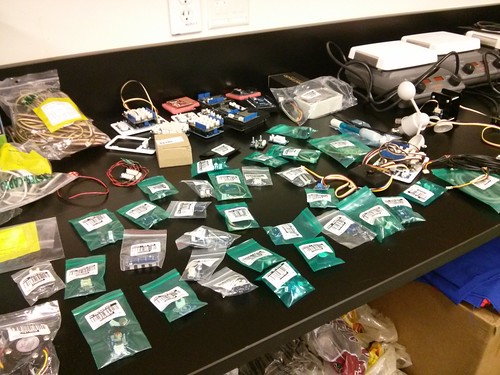








0 件のコメント:
コメントを投稿